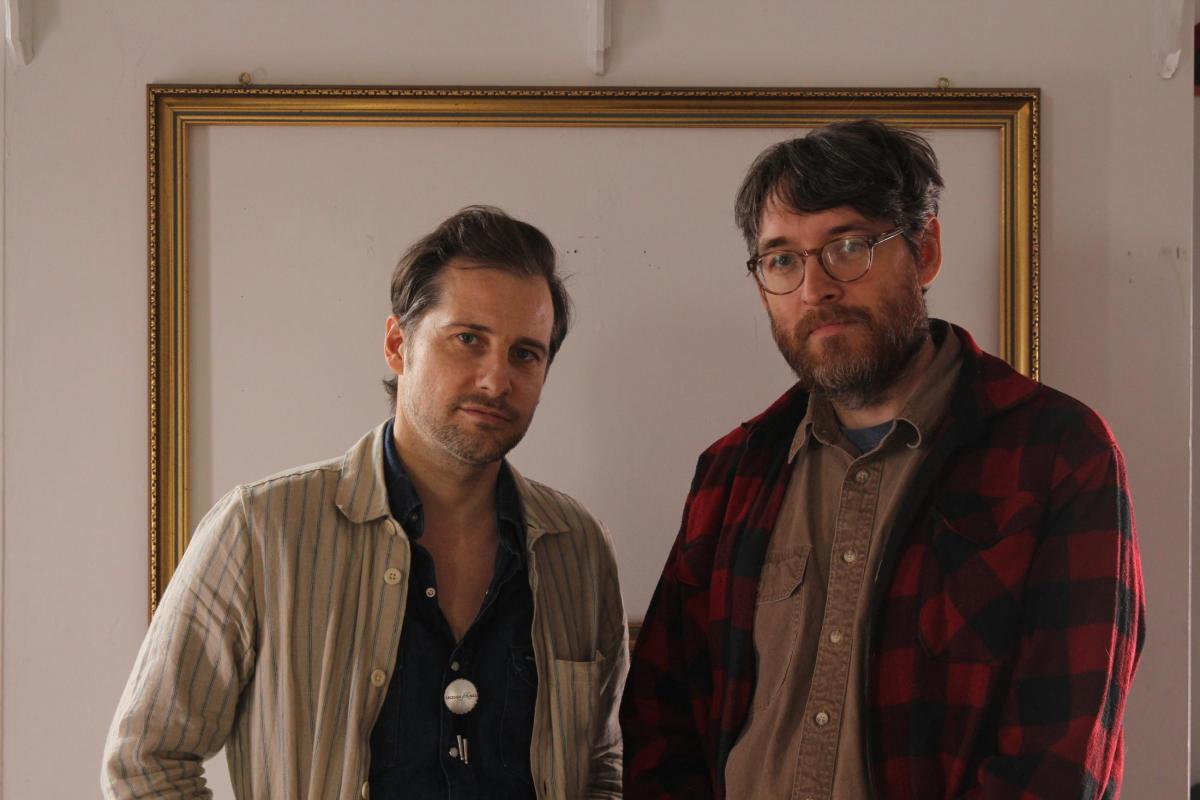
In 2011, Albert Birney met actor-director Kentucker Audley at the Maryland Film Festival. They vibed creatively, and stayed in touch. Shortly thereafter, Birney created a series of six-second films about a Hawaiian-shirt-sporting gorilla named Simply Sylvio, and was racking up lots of views on the microvideo platform Vine. Audley had an idea: What if they turned those shorts into a full-length film? The result, Sylvio, co-written and co-directed by the two men and co-starring Audley, was a film festival smash hit.
Now, Birney and Audley are back with Strawberry Mansion, an impossible-to-describe (by design) surrealist sci-fi romance/fantasy that features Audley as Preble—a buttoned-up “dream auditor.” Preble visits an elderly woman named Bella, who has stubbornly refused to submit her dreams to the government.
The film opens this Friday, February 18, at the Charles Theatre. But before that, on Thursday, you can catch a special screening with Birney, who will be around for a post-viewing Q&A. Dan Deacon, who scored the film, will also be in attendance.
I recently sat down with Birney over Zoom to talk about his and Audley’s singular creation.
In my original review of Strawberry Mansion, back when it played the 2021 Maryland Film Festival, I said that it reminded me of Charlie Kaufman’s films. Upon second viewing, I see a bit of John Waters, as well. Is that influence inevitable if you grow up in Baltimore?
I think it probably is! Just being from Baltimore his influence is definitely lodged somewhere deep in the back of my head. And the way that he made all his kind of early movies especially, from the ’70s and ’80s—all that DIY stuff with his friends—I’m really inspired by that to this day. You make the movie with whoever you have around you and you do it by any means necessary.
And you actually met him, right?
I was in a film class in high school [at Gilman]. I guess it was my senior year, so this would’ve been 1999 or 2000, and we got to go visit the set of Cecil B. Demented. It was my first time ever on any kind of set and my eyes were huge. There were maybe seven or eight of us in the class. And we all walked in wearing ties, because at Gilman you had to wear ties, and John looked at us and said, “Who let the choir boys in?” I thought that was so cool. We got a photo with him. I don’t know where that photo ended up but I would love to track that down some day.
I was surprised to hear that your first script for Strawberry Mansion was written in 2008. It seems so relevant to today—in using dream auditing as a metaphor for constant internet surveillance.
I know. Honestly, I was always so worried over the years that by the time we made it it was going to be obsolete. Right when it was premiering last year people kept sending us this article about a company that was actually trying to put dreams into your head. I don’t want to name the company now and give them free advertising, but it was like, yeah, here we are, they’re trying to do it right now.
One of the reasons I didn’t like Adam McKay’s Don’t Look Up was that its satire was too on-the-nose.
That’s why we didn’t want to get too technical with how dreams were audited or recorded, and leaned more into the fantasy and the romance and the feeling of dreaming and being lost in these other world. Whatever you end up doing in terms of sci-fi or satire, it can be dated very quickly. To me, that’s never been the interesting part of these movies. You mentioned Charlie Kaufman earlier. With Eternal Sunshine, I love how in that movie, you see the procedure happening but they never go into the details of how they’re erasing memories. It’s just like, “This is something that you can do. Now let’s get to the fun part.”
Let’s talk about locations. It was all shot in Maryland?
Yeah, 100 percent filmed in Maryland.
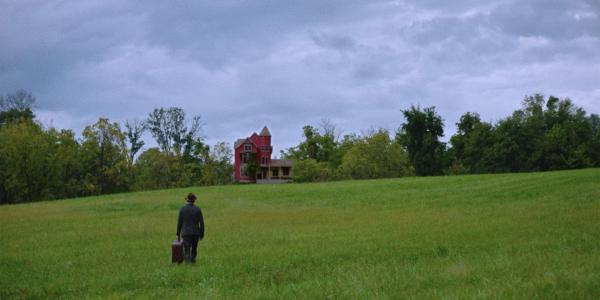
And the house where Bella lives, the mansion itself. Is there really such a place on a hill like that? Or was there some CGI there?
Well, it’s not CGI but it’s not a real house either. It’s a miniature dollhouse that I found on a thrift store on York Road that is now closed. We painted it and kind of added on different rooms, put a new roof on it….
I tell ya, we looked all over for a real house. We were working with the Maryland Film Commission. They had on their website a list of all these houses, and they had this [grainy picture] of the most amazing house. It was out near Bel Air and one of the producers and I drove out there and we were so excited. We were like, this is it! This is it! And we drove over the crest of this hill and it was just this empty field. The house had been demolished.
That was the last straw. We’d been all over Maryland. Every time we thought we had the house, something wasn’t quite right. It was like, alright, we’re just going to use this miniature. And it kind of worked in the end, because we could burn it for the big finish. It also kind of gives it that fantastical feeling when he’s walking toward it. It’s a little too perfect down in the distance.
My mind is blown. I 100-percent thought that was a real house.
In the beginning when we would answer that question, I don’t think I would give away that kind of secret but as the months have gone on now…I personally love learning about how movies are made. Hopefully somebody out there will hear that and maybe it will inspire them to get a dollhouse out of the attic and make a movie.
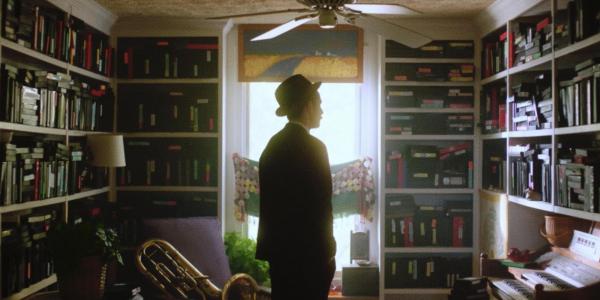
What about the wonderfully cluttered interior? I hate to use this cliché, but it feels like a character in the film.
That’s actually the house I grew up in! My mom and stepdad live there. My mom’s a wonderful woman. I always knew she was artistic but I realized as I got older that a lot of her art practice is her home, and the way that she decorates it, finds objects and repurposes them, and makes them into this really eccentric house. So honestly, we moved a lot of things around. We put different things on the walls here and there. But there was a lot of that already kind of fit for the character. My mom maybe isn’t too different from Bella. Without my mom and my step-dad very graciously opening up their home to our crew, the movie would not have been made at all.
That house had lots of cool stuff in it.
Over the years, my mom always served as an unofficial prop person. I was making a Vine once with these chickens and I said, “Hey mom, do you have any feathers?” And she was like, “Oh yeah, I’ve got feathers. I’ve got brown feathers, black feathers, white feathers.” And she brings out these Ziploc bags that she’s just been keeping somewhere in the house. I don’t think I’ve ever been able to stump her. She’ll just go down to the basement and rummage through shelves and boxes and come up with the perfect prop or exactly what I needed. The feeling of the house, a lot of it is due to her.
Let’s talk about the giant headgear thingy that Preble wears to enter dreams. How did you come up with that?
I think originally Kentucker had seen this image from the 1920s or 1930s. It was this kind of isolation helmet that you were supposed to put on to block out the world and concentrate on whatever you wanted to concentrate on. It was really bizarre. It had these two little eye holes. He said to me: What if it’s something like this? And I loved that idea. This big, bulky contraption that’s got a tube leading to the tape.
And then my girlfriend, Marnie Ellen Hertzler—she’s a filmmaker, too—she helped with the props a lot. She built that. She built the helmet that blocks out the ads and the giant chicken bucket that the witch has.
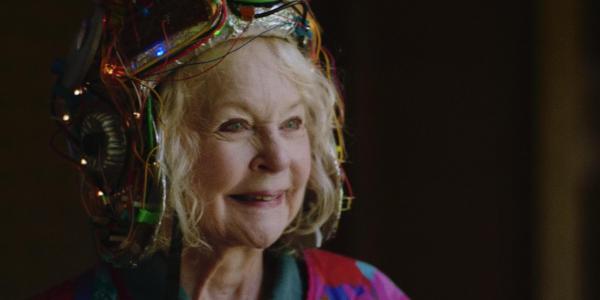
There are actually lots of contraptions and props in the film that give it a retro sci-fi quality. Is that what you were going for?
Yeah, exactly. I think a lot of the new sci-fi, a show like Black Mirror or something, all the technology is getting so teeny. You put a little dot on your forehead and suddenly it’s virtual reality. I think that’s cool and probably more realistic in terms of where we’re all headed, but there’s something so fun about these huge machines that you used to see in science fiction from the ’50s, ’60s, into the ’7os and ’80s—you’d always see these bulky things. And we always felt like: This is our movie. We’re making this world. And we can do whatever we want! If we want Preble’s car to be from the 1960s, we can do that. If we want him to dress like he’s a detective in the 1940s, we can do that.
Kind of combining all these different eras and concepts and putting them together. If somebody watches this and can get behind that in the first couple of minutes, they’re going to lost in the movie with us. It’s really, let’s just throw all logic out the window. And let’s just get lost in this wild journey together.
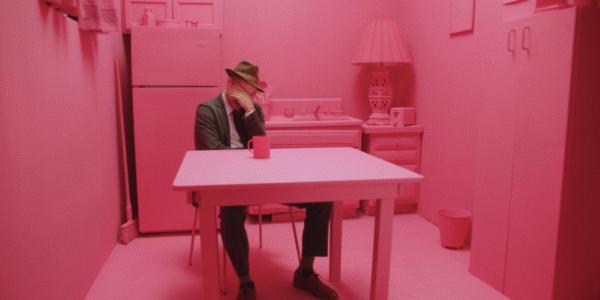
What was it like working with Dan Deacon?
He brought so much to the movie. Sometimes when you’re editing the same scenes over and over again you kind of stop seeing them a little bit. It’s hard to feel that energy again. And then Dan would send us these songs and all of a sudden, the scene would come alive again and I’d start to see things I had never seen before. Dan was a very thorough and very contemplative collaborator. He’d send us emails that were four paragraphs long about why he picked the harp for this one character or why a melodic line made sense here. It was a treat to work with someone who put so much thought into it.
Okay, here comes my “that one person in the audience at the film festival who asks the annoying question” moment. Preble goes into Bella’s dreams but Bella is in the dreams. Since we’re not visible in our own dreams, how does that work?
So he’s going into Bella’s dreams and he’s seeing Bella because he’s from the point of view of the hologram. He’s not in the POV of the dreamer. It’s virtual reality.
Can you explain the tape people—literally creatures made of video tape—to me? Am I supposed to understand that or not?
That’s one thing we left open. One interpretation is that they are like literally your dreams. All your dreams are recorded on these tapes. Years and years of these dreams become these walking characters. The image of them walking toward the house. To me, it’s like all your dreams are going home. This is where your essence lives, your soul—and all our dreams one day return there.
One thing Kentucker and I realized: Maybe it’s okay if we don’t give all the answers and just kind of pose some questions. I would hate for someone to have another interpretation of the tape people and me just kind of erasing it. If you have another idea of who they are and it makes sense in your head, then that’s the correct answer.
